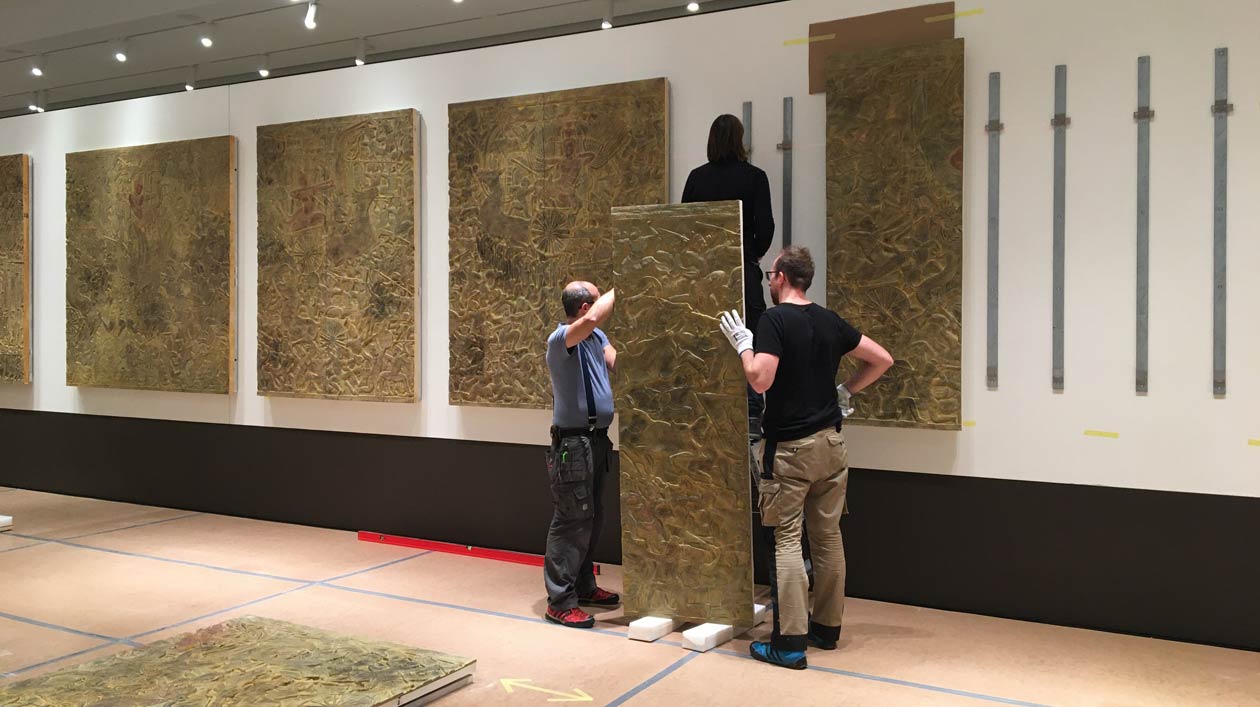New Year Gets Underway with a Major Logistical Effort
News from 12/17/2020
Although the Humboldt Forum had only a digital opening yesterday evening in view of the coronavirus pandemic, work is nevertheless proceeding at full steam in the museums. Toralf Gabsch, chief restorer at the Museum für Asiatische Kunst (Asian Art Museum) and responsible for the move of the Ethnologisches Museum (Ethnological Museum), is constantly going back and forth between Dahlem and Mitte.

The South Sea boats and the Cave of the Ring-Bearing Doves were very popular in Dahlem. How are they being shown at the Humboldt Forum?
Toralf Gabsch: The South Sea boats will be shown at the Humboldt Forum in a specially designed cube measuring over two stories high. Unlike in Dahlem, visitors can go down to the boats via a staircase in the exhibition room itself, as well as admiring them from a gallery above. A cube of identical construction situated opposite will feature a similar arrangement. That one will accommodate the ensemble of South Sea houses, including the men's clubhouse from the archipelago of Palau. For the first time, visitors will be able to get a bird's-eye view of these large exhibits, too.
The Cave of the Ring-Bearing Doves is surrounded by a two-story gallery of display cases. Here, visitors can view many of the items obtained during the Turfan expeditions conducted between 1902 and 1914. These small finds, which include sculptures, reliefs, tools, jewelry, coins, and capitals, were previously only available for research at the Dahlem warehouses and for the most part were not accessible to the public. The cave presentation structure uses a special system involving two separate shells. The inner load-bearing structure, made of wood, is designed for the wall paintings only and is self-supporting. The external structure, which supports the gallery and the display cases, is made of metal. This system is needed so that any vibrations, such as those that might be caused by visitors walking in the upper gallery, are not transmitted to the wooden structure and the paintings attached to it.
The presentation of the Museum für Asiatische Kunst will be larger than the one in Dahlem. What is changing?
The Museum für Asiatische Kunst will actually be enlarged by quite a lot. There will be an extra 1,000 square meters compared to the old exhibition in Dahlem. But the extra floor space isn't all. Some of the architectural features of the space are also spectacular, and that will help us create the best possible presentation of our collection. One special attraction for visitors is sure to be the room designed by Wang Shu with its distinctive wooden-beamed ceiling, modeled on the structure of Chinese pagodas. The art of the Chinese court will be shown here, as well as the Teahouse by Ai Weiwei, for example. In addition to the Cave of the Ring-Bearing Doves, we can also show the partially reconstructed Cave of the Sixteen Sword-Bearers at the Humboldt Forum. Because of a lack of space, only selected paintings from this cult cave were shown in the past. Now, though, for the first time in over a hundred years, it will be possible to experience the whole cave, including the unique depictions of Tocharian princes on the walls of its passages. The Humboldt Forum is the only museum in the world where caves of this particular sort can be seen. The archaeological paintings represent the life and death of the Buddha and offer insights into far-reaching cultural and artistic relationships that existed along the Silk Road.
You probably only move an entire museum like this once in a lifetime, right? What are the biggest challenges?
The biggest challenges in the last eleven years were firstly, occasional delays in deciding which groups of objects would be displayed at the Humboldt Forum and, secondly, the sheer scale of the collections being moved. You only move 27,000 museum objects once in a lifetime. To understand the scale of what's involved, it helps to compare us with neighboring museums. Our floor space at the Humboldt Forum is practically the same as the combined space of the Altes Museum, the Alte Nationalgalerie and half of the Neues Museum. So we are basically moving half of the total area of Museum Island in one go, which is probably unprecedented in the museum world on this scale, in terms of the logistics and the handling of the pieces.
Another special challenge is to maintain a stable climate in the exhibition spaces. This is necessary to prevent damage to the objects, some of which are very sensitive, and many of which – in the case of the Ethnologisches Museum – consist of organic materials. In view of the dimensions of the Humboldt Forum, it was a Herculean task that kept us and the technical crews busy for a long time. But now that this has been sorted out, there is nothing to prevent us from going ahead with the move early next year. We will bring about 140 truckloads of exhibits from Dahlem to Mitte. We really have our work cut out for us.
The interview was conducted by Stefan Müchler

